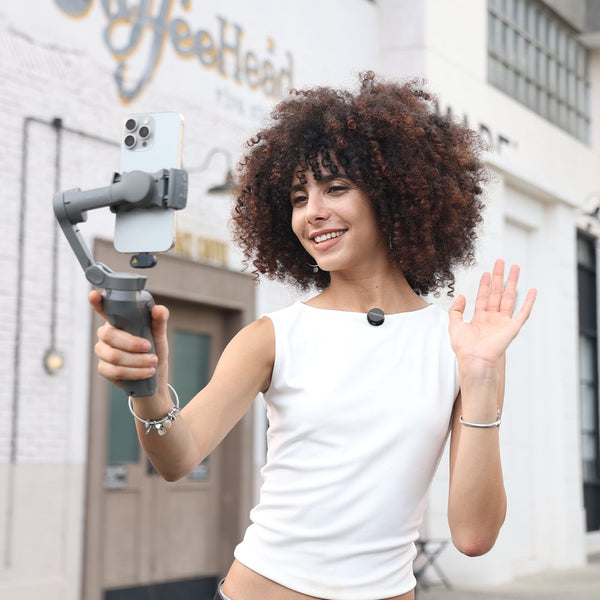
Storytelling Through Food: Turning Meals Into Engaging Content
Food is more than just sustenance—it’s a story, a cultural exchange, and for many vloggers, it’s the gateway to connecting with audiences worldwide. Vietnamese cuisine, with its vibrant colors, fragrant herbs, and rich balance of flavors, is one of the most exciting culinary traditions to capture on camera. But great storytelling in food vlogging isn’t only about the dishes—it’s also about how you present them. From the first bite of a steaming bowl of pho to the crunch of a fresh banh mi, every sound and every detail matters.
That’s why successful food vloggers combine authentic dining experiences with the right tools for clear audio and video capture. Using a recording microphone wireless setup, vloggers can ensure their voices are crisp and engaging. This guide will walk you through Vietnamese cuisine essentials, must-try dishes to feature, and how to elevate your vlogs with a wireless microphone.
First-Time Guide to Eating Authentic Vietnamese Cuisine
If you’re new to Vietnamese food, think of it as a perfect balance of five flavors—sweet, salty, sour, bitter, and spicy. Meals often include fresh herbs, rice-based dishes, and savory broths. A traditional meal might feature rice or noodles, grilled or stir-fried meats, fresh vegetables, and dipping sauces like nuoc cham (a blend of fish sauce, lime, sugar, and chili).
When vlogging your first experience:
-
Show the freshness of ingredients.
-
Explain the cultural background of the dish.
-
Capture your first bite reaction, as this is what resonates most with viewers.
Your authenticity as a storyteller is what makes the audience feel like they’re sitting at the table with you.
Top Vietnamese Dishes Every Food Vlogger Should Feature in Bigmoe
Vietnamese food is as diverse as its regions. Here are six dishes that should be on your vlogging menu:
1. Spring Rolls (Gỏi Cuốn)
Fresh, not fried, these rolls are made with rice paper and stuffed with shrimp, herbs, vermicelli noodles, and pork. They’re often dipped in peanut sauce. Vloggers love filming the translucent rice paper wrap because it shows the bright, colorful fillings.
2. Vietnamese Chicken Noodle Soup (Phở Gà)

Pho is Vietnam’s most famous dish, and the chicken version is lighter than the beef counterpart. Highlight the process of adding lime, basil, bean sprouts, and chili to customize your bowl. Capture the steam rising—it’s food cinematography at its best.
3. Drip Coffee (Cà Phê Sữa Đá)
Vietnamese drip coffee is a cultural ritual. Show the slow drip of strong coffee over sweetened condensed milk. Audiences love the anticipation of stirring and tasting the first sip.
4. Vietnamese Dry Egg Noodle Soup (Mì Khô)
This noodle dish features chewy egg noodles served “dry” with sauce, usually accompanied by a small bowl of soup. The mix of textures—crispy shallots, soft noodles, and tender meat—makes it perfect for close-up shots.
5. Vietnamese Seafood Noodle Soup (Bún Hải Sản)
Packed with shrimp, squid, and clams, this soup is flavorful and aromatic. Vloggers can emphasize the freshness of seafood markets and the generous toppings in each bowl.
6. Banh Mi Sandwich

A fusion of French baguette and Vietnamese fillings, banh mi can feature pork, pâté, pickled vegetables, and fresh herbs. Show the crunch as you bite—it’s an audio moment your viewers will love, especially when captured with a wireless microphone for recording.
How to Capture Clear Food Reviews Using a Wireless Microphone
While visuals are vital, audio is the soul of vlogging. A wireless professional microphone ensures your voice is heard clearly even in noisy environments like bustling food streets.eets.
Tips for clear food review audio:
-
Position a lavalier mic close to your chest for natural voice capture.
-
Use a windshield or foam cover to reduce wind or street noise.
-
Speak at a moderate pace—your audience wants to savor the words as much as the food.
For smartphone vloggers, pairing your setup with a wireless android microphone makes capturing content much easier on the go.
Balancing Eating and Talking on Camera for Vlogs
One of the challenges of food vlogging is eating while narrating. To keep content engaging:
-
Take smaller bites so you can speak quickly afterward.
-
Use pauses for B-roll shots of the food, giving yourself time to chew.
-
Share cultural facts or personal impressions between bites.
Audiences enjoy seeing genuine enjoyment of food, but they also want to hear your insights. Strike the right balance, and your vlogs will feel natural and immersive.
Essential Gear for Food Vloggers: Why Wireless Mics Matter
Food vlogging often happens in unpredictable environments—street food markets, noisy cafes, or outdoor stalls. A recording wireless microphone is essential because:
-
It allows freedom of movement (you can walk around without being tethered).
-
It reduces ambient noise, focusing on your voice.
-
It makes your content look more professional, especially when synced properly with video.
For beginners, wireless microphones are no longer luxury items—they’re essential storytelling tools.
Beginner’s Setup for Food Vlogging: Camera, Wireless Mic & Angles
You don’t need Hollywood gear to start. A basic setup includes:
-
Camera/Smartphone: Modern smartphones shoot high-quality 4K video. Pair them with a tripod for stability.
-
Wireless Microphone: Consider budget-friendly options like the Maono Wave T5 or the compact Maono Wave T1 Mini for reliable sound. Both are strong picks if you’re looking for a wireless professional microphone that balances performance and affordability.
-
Lighting: Natural light is best. If shooting indoors, a ring light can help.
-
Angles: Alternate between wide shots of the setting, close-ups of the dish, and POV shots while eating.
This setup is lightweight, affordable, and perfect for beginner food vloggers.
Vietnamese Cuisine FAQs
1. What are the must-try Vietnamese dishes for beginners?
Start with pho, banh mi, spring rolls, and Vietnamese iced coffee. These represent the heart of Vietnamese cuisine.
2. How do I eat pho the traditional way?
Add herbs, lime, and chili to your taste. Slurping the noodles is perfectly acceptable!
3. Is banh mi always made with pork, or are there vegetarian options?
No, you can find banh mi with chicken, beef, tofu, or even eggs.
4. What is the difference between northern and southern Vietnamese food?
Northern dishes are lighter and less spicy, while southern cuisine uses more herbs, sugar, and bold flavors.
5. How spicy is Vietnamese cuisine compared to Thai food?
Vietnamese food is generally milder, with chili served as an optional condiment.
6. What drinks pair best with Vietnamese street food?
Vietnamese iced coffee, sugarcane juice, and iced lotus tea are popular.
7. Which Vietnamese desserts are popular with tourists?
Che (sweet soup), flan, and sesame balls are crowd favorites.
8. Are there etiquette tips when eating in a Vietnamese restaurant?
Yes, wait for the eldest person to start eating, and always use both hands when passing dishes.
9. What makes Vietnamese cuisine unique compared to other Asian foods?
The balance of fresh herbs, light broths, and French influences sets it apart.
10. Where can I find authentic Vietnamese food outside Vietnam?
Major cities worldwide have Vietnamese communities with authentic restaurants—look for areas like “Little Saigon.”
Wireless Microphone FAQs for Vlogging
11. Why should food vloggers use a wireless microphone instead of a wired one?
Wireless mics give freedom of movement and reduce the clutter of cables.
12. What’s the best budget-friendly wireless mic for beginner vloggers?
The Maono Wave T5 and Maono Wave T1 Mini are excellent starter options.
13. How do I set up a wireless mic for outdoor food vlogging?
Clip the mic near your collar, connect the receiver to your camera or phone, and test audio before recording.
14. Can wireless mics handle noisy environments like street markets?
Yes, especially if they have noise reduction features and foam covers.
15. What’s the difference between a lavalier wireless mic and a shotgun mic for vlogging?
Lavalier mics are discreet and close to your mouth, while shotgun mics capture sound directionally from the camera.
16. How far can I be from the camera before wireless mic quality drops?
Most models work reliably up to 30–50 meters, depending on interference.
17. Are there wireless microphones that connect directly to smartphones?
Yes, many models, including Maono’s, are designed for smartphone compatibility.
18. How do I avoid interference when vlogging with a wireless mic in crowded places?
Stay within range, avoid obstacles, and choose a mic with stable frequency hopping.
19. Do wireless mics need special apps or software for recording?
Not usually. Most connect directly to your device and work with standard video apps.
20. What’s the best way to sync wireless mic audio with video for food vlogs?
Use editing software like Premiere Pro or CapCut. Some wireless mics even auto-sync when paired.
Conclusion
Vietnamese food vlogging is more than filming dishes—it’s about immersing your audience in the culture, flavors, and atmosphere of each meal. By featuring iconic dishes like pho, banh mi, and drip coffee, you transport viewers to the heart of Vietnam.
Visiting the Bigmoe Vietnamese restaurant feels like discovering a hidden gem in the city (I live in the Philippines, by the way). I enjoyed the warmth of the ambience and the hospitality of the staff—who may also be the owners—as they made us feel at home and enhanced our dining experience. Overall, I must say I love Vietnamese cuisine for the freshness and variety of its ingredients, and I’m sure I’ll be back for more.
Also, with the right recording microphone wireless setup, your audience doesn’t just see the food—they hear your excitement, reactions, and authentic storytelling clearly.
Whether you’re a beginner or an aspiring pro, combining authentic cuisine experiences with the right vlogging tools—like a wireless android microphone or a wireless professional microphone—can turn your food journey into engaging content that resonates worldwide.



